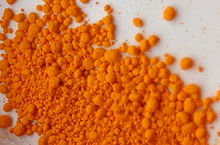This is an old revision of this page, as edited by Beetstra (talk | contribs) at 09:23, 10 April 2012 (Saving copy of the {{chembox}} taken from revid 483835854 of page Mercury(II)_oxide for the Chem/Drugbox validation project (updated: 'StdInChI').). The present address (URL) is a permanent link to this revision, which may differ significantly from the current revision.
Revision as of 09:23, 10 April 2012 by Beetstra (talk | contribs) (Saving copy of the {{chembox}} taken from revid 483835854 of page Mercury(II)_oxide for the Chem/Drugbox validation project (updated: 'StdInChI').)(diff) ← Previous revision | Latest revision (diff) | Newer revision → (diff)| This page contains a copy of the infobox ({{chembox}}) taken from revid 483835854 of page Mercury(II)_oxide with values updated to verified values. |

| |

| |
| Names | |
|---|---|
| IUPAC name Mercury(II) oxide | |
| Other names
Mercuric oxide Montroydite | |
| Identifiers | |
| CAS Number | |
| ChemSpider | |
| KEGG | |
| RTECS number |
|
| UN number | 1641 |
InChI
| |
| Properties | |
| Chemical formula | HgO |
| Molar mass | 216.591 g·mol |
| Appearance | Yellow or red solid |
| Odor | odorless |
| Density | 11.14 g/cm |
| Melting point | 500 °C (decomposes) |
| Solubility in water | 0.0053 g/100 mL (25 °C) 0.0395 g/100 mL (100 °C) |
| Solubility | insoluble in alcohol, ether, acetone, ammonia |
| Band gap | 2.2 eV |
| Refractive index (nD) | 2.5 (550 nm) |
| Structure | |
| Coordination geometry | orthorhombic |
| Thermochemistry | |
| Std molar entropy (S298) |
70 J·mol·K |
| Std enthalpy of formation (ΔfH298) |
−90 kJ·mol |
| Hazards | |
| NFPA 704 (fire diamond) |
 |
| Flash point | Non-flammable |
| Related compounds | |
| Other anions | Mercury sulfide Mercury selenide Mercury telluride |
| Other cations | Zinc oxide Cadmium oxide |
| Except where otherwise noted, data are given for materials in their standard state (at 25 °C , 100 kPa).
| |
- ^ "Mercury oxide (HgO) crystal structure, physical properties". Vol. 41B. Springer-Verlag. 1999. pp. 1–7. doi:10.1007/b71137. ISBN 978-3-540-64964-9.
{{cite book}}:|work=ignored (help); Missing or empty|title=(help) - ^ Zumdahl, Steven S. (2009). Chemical Principles 6th Ed. Houghton Mifflin Company. p. A22. ISBN 061894690X.